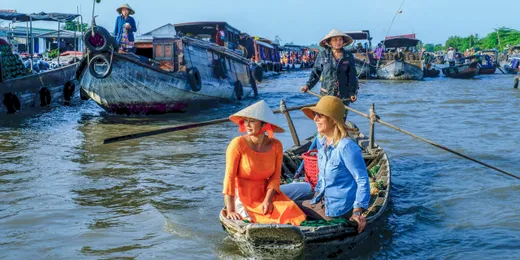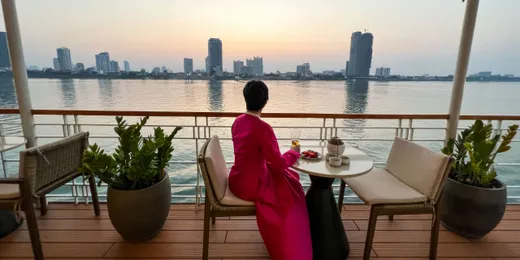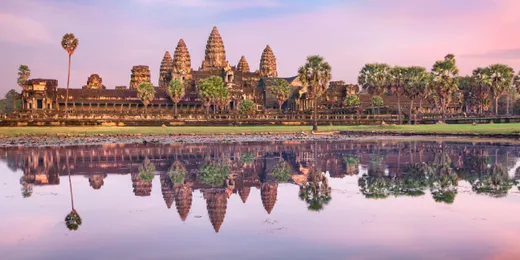
Experience the treasures of the Mekong River
Discover the iconic architecture, distinctive cultures and intriguing history that await you in Vietnam and Cambodia. From its idyllic landscapes to its bustling cities, this captivating region offers curious travelers a wide variety of delights. Read on to learn more about Khmer cuisine, delve into the unique tradition of floating markets and enhance your knowledge of Cambodia’s storied past.

Mekong
As with the Yangtze and Ganges Rivers, the Mekong River begins in Lasagongma Spring on Mt. Guozongmucha in the Tibetan Plateau—the largest source of fresh water outside the polar ice caps. On its 3,000-mile (4,828 km) journey, the Mekong winds through China before forming the international borders of China, Myanmar, Laos and Thailand in what is called the “Golden Triangle.” Its most dramatic drop occurs right before the triangle, when the roiling waters plunge almost 15,000 ft. (4,572 m); after that, it straightens and continues another 1,600 mi. (2,575 km) through Laos, Thailand, Cambodia and Vietnam before splintering off into a richly fertile delta and flowing into the South China Sea.
Many of Southeast Asia’s largest cities lie on the banks of the Mekong, including Phnom Penh, the capital of Cambodia, and Ho Chi Minh City (formerly Saigon), Vietnam. If you are sailing downriver, you will see the scenery change rather quickly. Shiny new skyscrapers and casinos give way to banana trees and fields of rice and corn in the delta, where the majority of people live in the countryside. Opportunities to earn a living here are primarily limited to either farming or fishing.
Second only to the Amazon River in terms of biodiversity, the Mekong is home to at least 1,100 freshwater species, including the Siamese crocodile, some of the last remaining Irrawaddy dolphins, the giant ibis, carp, stingrays—weighing in at 1,300 lbs. (589 kg)—and catfish reaching up to 10 ft. (3 m) in length. The Mekong River basin boasts one of the world’s largest and most productive inland fisheries, yielding about 4.5 million tons of fish and aquatic products annually with an economic value of around $7 billion a year.
People have lived in the Greater Mekong region for more than 4,000 years, during which the Mekong River has been an important thoroughfare for people marketing their goods. Mainly populated by Vietnamese, the region’s floating villages are almost self-contained—a world in which many people spend much, if not all, of their lives without ever setting foot on land, and where local farmers displaying their chickens or crops steer narrow handmade boats through floating markets.
Although navigation conditions vary greatly along the length of the Mekong, this impressive river is also becoming an important link in international trade routes, connecting the six Mekong countries to each other and the rest of the world.

-
Cuisine—Cambodian cuisine
Although Cambodian—or Khmer—cuisine is often thought to be indistinguishable from that of its neighbors, Thailand and Vietnam, it differs in several important ways. For one, the spice level is comparatively mild. A bowl of small chilies is commonly served alongside meals, allowing the diner to add spice to the food at their discretion. In place of the heat, many Cambodian dishes boast distinct pickled or tangy flavors. This is often achieved through the use of kapi, or fermented shrimp paste, in addition to the ubiquitous fermented fish paste known as prahok. The presence of large amounts of garlic is another hallmark of this singular cuisine, as is a wide variety of locally grown vegetables.
While the Vietnamese adore their pho soup and the Thais their khao tom (boiled rice porridge served with egg and/or meat), Cambodians prefer to start their morning with a steaming bowl of kuy teav, or meat and noodle soup. Nom banh chok (rice noodles smothered in a fish-based green curry sauce) or a simple breakfast of bai sach chrouk (grilled pork and rice) are also popular choices.
When it comes to unusual snacks, fried ants and crickets are found throughout Southeast Asia, but Cambodians also have a particular taste for tarantulas. Eaten in earnest during the famine-stricken days of the Khmer Rouge regime, the arachnid’s crab-like flavor quickly caught on, and today they are considered a delicacy. These crunchy treats are usually stir-fried in a wok and are said to be the perfect accompaniment to a cold glass of beer.
From insects to indigenous herbs, Cambodia boasts a culture and a cuisine all its own. Among the many spices grown in this resilient country, the revered Kampot pepper reigns supreme. Floral and slightly sweet with a long, lingering aftertaste, this exquisite variety has been cultivated in Cambodia for centuries, becoming an important export during the country’s time under French colonial rule. Though the industry was forced into a period of serious decline due to the Khmer Rouge regime’s autocratic policies, it has since begun the slow process of rebuilding. In addition to appearing on the menus of some of the world’s top restaurants, Kampot pepper can now be found locally in dishes including loc lac (stir-fried beef strips set atop a green salad served with a lime-and-pepper dipping sauce) and sautéed crab and pepper.
-
Culture—Floating markets
The tradition of selling products from boat to boat goes back more than 100 years, and the Mekong Delta is home to hundreds of floating markets. With so many interesting goods for sale in these markets, you can look, smell, taste and buy your way through a veritable cornucopia.
Trading begins before dawn. By sunrise, the waterways are decorated with an army of brightly painted sampans (small, flat-bottomed wooden boats) jockeying for position as everything from pineapples, herbs and citrus to turtles, snakes and potbellied pigs quickly change hands.
Wholesalers moor here, each specializing in one or a few types of fruit or vegetables. Bigger boats snap everything up by the bushel and resell it in the big cities. Vendors of smaller items hoist samples on a bamboo pole so their goods are visible from a distance. Some vendors' lives are so linked to boats that they do not just work on the river; they also live there.
Shoppers arrive by land and water, signaling their wish to purchase by simply whistling or waving their hand. In the future, with more transportation moving to newly built roads, it could become rare to experience this historic boat-to-boat trading atmosphere on the Mekong.
-
History—The spirit of Cambodia
It would be a mistake to define the spirit of Cambodia strictly by the soaring glory of Angkor Wat, the meandering Mekong River or the heady mix of ancient and modern architecture found in Phnom Penh and Siem Reap. Beyond these calling cards, Cambodia is—remarkably, after its dark and recent past—a country at peace with itself. What defines the spirit of Cambodia? Surely its people, who leave a lasting impression on visitors.
The story of Cambodia begins in 4000 BC with the first settlements. By the 13th century, it had grown into a major power as the Khmer kingdom, with territory in today’s Vietnam, Laos, Thailand, Myanmar and Malay Peninsula. Angkor Wat, built in the then-capital of Angkor in the 12th century, stands today as the most impressive remnant of Khmer might. Its completion as a royal mausoleum punctuated a renaissance the likes of which Southeast Asia had never seen.
With the Siamese insurgence of the 15th century, the capital was moved south to Phnom Penh. Angkor was abandoned and left to decay until French archaeologists, with the support of the French protectorate that had moved in to oversee the country in 1863, began the long work of excavation and restoration.
The French ruled the region for 90 years until independence was gained in 1953. Entanglements with the North Vietnamese and the US in the 1960s and 1970s culminated in the emergence of the brutal dictator Pol Pot and the Khmer Rouge. The death of millions of Cambodians due to starvation, massacre and disease followed during one of the most notorious genocides the world has ever seen. Approximately 25 percent of the country’s total population met their end during the Khmer Rouge’s four-year reign of terror; any hint of opposition to Pol Pot’s government, including the pursuit of independent thought, led to execution. Vietnam soon intervened to depose Pol Pot and in 1979 the Khmer Rouge regime was soundly defeated, ushering in a new era of peace in Cambodia.
With its freedom to rediscover its rich heritage restored, today’s Cambodia is a vibrant tableau of green rice fields, rolling hills, French-influenced cities and the sinewy course of the Mekong. This is due in no small part to the remarkable resilience and spirit of the Cambodian people, known to be quick with a smile and a warm welcome.
Mekong Highlights
A voyage through Vietnam and Cambodia promises exceptional scenic beauty, historic architecture and rich cultural traditions to discover. Here are some sample highlights you may experience on a voyage along the Mekong River:
- Attend a performance at the Saigon Opera House in Ho Chi Minh City
- Sample homemade snacks with locals in Cái Bè
- Ride a traditional sampan in Sa Ðéc
- Visit a floating fish farm in Tân Châu
- Wander through Hanoi’s charming Old Quarter
- Tour Phnom Penh on your own private rickshaw
- Receive a blessing from Buddhist monks at Udon Monastery
- Learn about silk weaving in Koh Oknha Tay
- Ascend the Twin Holy Mountains of Phnom Pros and Phnom Srey
- Explore the 12th-century temple of Angkor Wat
- Take a sunset boat ride to the floating villages of Tonlé Sap
- Discover Cambodian cuisine during a hands-on cooking class
Destination Insight Videos
-
Uncover cuisine found along the Mekong River with Karine Hagen (6:54)
Journey along the Mekong River with Viking’s Karine Hagen and enhance your understanding of why this waterway truly is the “Mother River of Southeast Asia.” Karine is joined by one of her best friends, Chi, as they explore the floating markets along the Mekong Delta, observing boats brimming with tropical fruits, vegetables and other local delicacies. They later prepare a worldwide culinary favorite, Vietnamese summer rolls—known to locals as gỏi cuốn, which translates to “salad roll.” Learn how to prepare this light, delectable appetizer and a flavorful dipping sauce.
-
At Home on the Mekong Delta with Thu Tran (9:30)
Join local guide Thu Tran as she takes us on a tour of everyday life along the Mekong Delta in Vietnam. Thu has worked with Viking since 2015 and has been a tour guide for over 15 years. In this episode, follow Thu as she explores the food and vegetable markets of the Mekong Delta and the many farms that supply their produce.
-
Postcards from the Mekong River with photographer Alastair Miller (17:00)
Delve into the heart of Southeast Asia with British photographer Alastair Miller. Follow along as Alastair shares stunning photographs and captivating anecdotes from his recent travels during our 15-day Magnificent Mekong voyage. Enjoy seeing the traditional floating markets, serene landscapes and vibrant cultures that await your discovery on a Mekong River voyage with us.
-
Discover the fascinating history of Angkor with Dr. John Freedman (1:36:11)
Join guest lecturer Dr. John Freedman once again for his fascinating presentation on the Khmer Empire titled “The Glorious History of Angkor.” Learn how Cambodia’s Angkor thrived as the capital city of the Khmer Empire between the 9th and 15th centuries.
Mekong Travel FAQ
Enriching Itineraries—Mekong
Choose one of our immersive voyages and discover the many benefits of exploring in Viking comfort.












